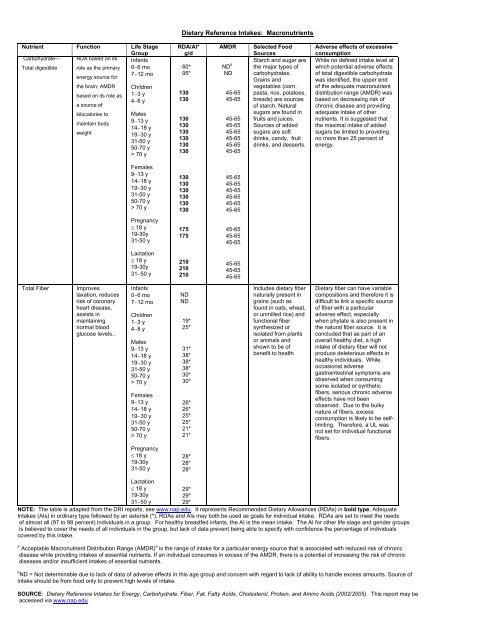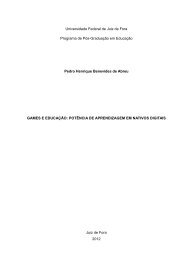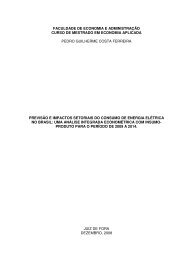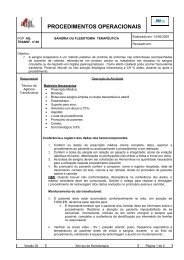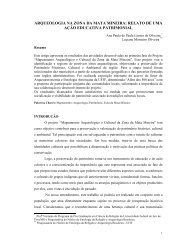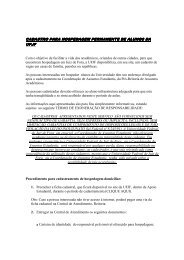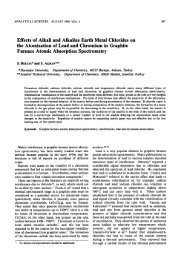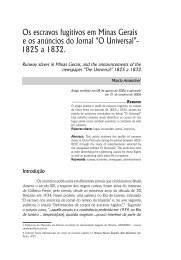Dietary Reference Intakes: Macronutrients
Dietary Reference Intakes: Macronutrients
Dietary Reference Intakes: Macronutrients
Create successful ePaper yourself
Turn your PDF publications into a flip-book with our unique Google optimized e-Paper software.
Nutrient Function Life Stage<br />
Group<br />
Carbohydrate— RDA based on its Infants<br />
Total digestible role as the primary 0−6 mo<br />
energy source for<br />
7−12 mo<br />
the brain; AMDR Children<br />
based on its role as 1−3 y<br />
a source of<br />
4−8 y<br />
kilocalories to Males<br />
maintain body<br />
weight<br />
9−13 y<br />
14−18 y<br />
19−30 y<br />
31-50 y<br />
50-70 y<br />
> 70 y<br />
Total Fiber Improves<br />
laxation, reduces<br />
risk of coronary<br />
heart disease,<br />
assists in<br />
maintaining<br />
normal blood<br />
glucose levels..<br />
Females<br />
9−13 y<br />
14−18 y<br />
19−30 y<br />
31-50 y<br />
50-70 y<br />
> 70 y<br />
Pregnancy<br />
≤ 18 y<br />
19-30y<br />
31-50 y<br />
Lactation<br />
≤ 18 y<br />
19-30y<br />
31−50 y<br />
Infants<br />
0−6 mo<br />
7−12 mo<br />
Children<br />
1−3 y<br />
4−8 y<br />
Males<br />
9−13 y<br />
14−18 y<br />
19−30 y<br />
31-50 y<br />
50-70 y<br />
> 70 y<br />
Females<br />
9−13 y<br />
14−18 y<br />
19−30 y<br />
31-50 y<br />
50-70 y<br />
> 70 y<br />
Pregnancy<br />
≤ 18 y<br />
19-30y<br />
31-50 y<br />
Lactation<br />
≤ 18 y<br />
19-30y<br />
31−50 y<br />
<strong>Dietary</strong> <strong>Reference</strong> <strong>Intakes</strong>: <strong>Macronutrients</strong><br />
RDA/AI*<br />
g/d<br />
60*<br />
95*<br />
130<br />
130<br />
130<br />
130<br />
130<br />
130<br />
130<br />
130<br />
130<br />
130<br />
130<br />
130<br />
130<br />
130<br />
175<br />
175<br />
210<br />
210<br />
210<br />
ND<br />
ND<br />
19*<br />
25*<br />
31*<br />
38*<br />
38*<br />
38*<br />
30*<br />
30*<br />
26*<br />
26*<br />
25*<br />
25*<br />
21*<br />
21*<br />
28*<br />
28*<br />
28*<br />
29*<br />
29*<br />
29*<br />
AMDR<br />
ND b<br />
ND<br />
45-65<br />
45-65<br />
45-65<br />
45-65<br />
45-65<br />
45-65<br />
45-65<br />
45-65<br />
45-65<br />
45-65<br />
45-65<br />
45-65<br />
45-65<br />
45-65<br />
45-65<br />
45-65<br />
45-65<br />
45-65<br />
45-65<br />
45-65<br />
Selected Food<br />
Sources<br />
Starch and sugar are<br />
the major types of<br />
carbohydrates.<br />
Grains and<br />
vegetables (corn,<br />
pasta, rice, potatoes,<br />
breads) are sources<br />
of starch. Natural<br />
sugars are found in<br />
fruits and juices.<br />
Sources of added<br />
sugars are soft<br />
drinks, candy, fruit<br />
drinks, and desserts.<br />
Includes dietary fiber<br />
naturally present in<br />
grains (such as<br />
found in oats, wheat,<br />
or unmilled rice) and<br />
functional fiber<br />
synthesized or<br />
isolated from plants<br />
or animals and<br />
shown to be of<br />
benefit to health<br />
Adverse effects of excessive<br />
consumption<br />
While no defined intake level at<br />
which potential adverse effects<br />
of total digestible carbohydrate<br />
was identified, the upper end<br />
of the adequate macronutrient<br />
distribution range (AMDR) was<br />
based on decreasing risk of<br />
chronic disease and providing<br />
adequate intake of other<br />
nutrients. It is suggested that<br />
the maximal intake of added<br />
sugars be limited to providing<br />
no more than 25 percent of<br />
energy.<br />
<strong>Dietary</strong> fiber can have variable<br />
compositions and therefore it is<br />
difficult to link a specific source<br />
of fiber with a particular<br />
adverse effect, especially<br />
when phytate is also present in<br />
the natural fiber source. It is<br />
concluded that as part of an<br />
overall healthy diet, a high<br />
intake of dietary fiber will not<br />
produce deleterious effects in<br />
healthy individuals. While<br />
occasional adverse<br />
gastrointestinal symptoms are<br />
observed when consuming<br />
some isolated or synthetic<br />
fibers, serious chronic adverse<br />
effects have not been<br />
observed. Due to the bulky<br />
nature of fibers, excess<br />
consumption is likely to be selflimiting.<br />
Therefore, a UL was<br />
not set for individual functional<br />
fibers.<br />
NOTE: The table is adapted from the DRI reports, see www.nap.edu. It represents Recommended <strong>Dietary</strong> Allowances (RDAs) in bold type, Adequate<br />
<strong>Intakes</strong> (AIs) in ordinary type followed by an asterisk (*). RDAs and AIs may both be used as goals for individual intake. RDAs are set to meet the needs<br />
of almost all (97 to 98 percent) individuals in a group. For healthy breastfed infants, the AI is the mean intake. The AI for other life stage and gender groups<br />
is believed to cover the needs of all individuals in the group, but lack of data prevent being able to specify with confidence the percentage of individuals<br />
covered by this intake.<br />
a Acceptable Macronutrient Distribution Range (AMDR) a is the range of intake for a particular energy source that is associated with reduced risk of chronic<br />
disease while providing intakes of essential nutrients. If an individual consumes in excess of the AMDR, there is a potential of increasing the risk of chronic<br />
diseases and/or insufficient intakes of essential nutrients.<br />
bND = Not determinable due to lack of data of adverse effects in this age group and concern with regard to lack of ability to handle excess amounts. Source of<br />
intake should be from food only to prevent high levels of intake.<br />
SOURCE: <strong>Dietary</strong> <strong>Reference</strong> <strong>Intakes</strong> for Energy, Carbohydrate. Fiber, Fat, Fatty Acids, Cholesterol, Protein, and Amino Acids (2002/2005). This report may be<br />
accessed via www.nap.edu
Nutrient Function Life Stage<br />
Group<br />
Total Fat Energy source Infants<br />
and when found 0−6 mo<br />
in foods, is a<br />
source of n-6 and<br />
7−12 mo<br />
n-3<br />
polyunsaturated<br />
fatty acids. Its<br />
presence in the<br />
Children<br />
1−3 y<br />
4−8 y<br />
diet increases<br />
absorption of fat<br />
soluble vitamins<br />
and precursors<br />
such as vitamin A<br />
and pro-vitamin A<br />
carotenoids.<br />
Males<br />
9−13 y<br />
14−18 y<br />
19−30 y<br />
31-50 y<br />
50-70 y<br />
> 70 y<br />
n-6<br />
polyunsaturated<br />
fatty acids<br />
(linoleic acid)<br />
Essential<br />
component of<br />
structural<br />
membrane lipids,<br />
involved with cell<br />
signaling, and<br />
precursor of<br />
eicosanoids.<br />
Required for<br />
normal skin<br />
function.<br />
Females<br />
9−13 y<br />
14−18 y<br />
19−30 y<br />
31-50 y<br />
50-70 y<br />
> 70 y<br />
Pregnancy<br />
≤ 18 y<br />
19-30y<br />
31-50 y<br />
Lactation<br />
≤ 18 y<br />
19-30y<br />
31−50 y<br />
Infants<br />
0−6 mo<br />
7−12 mo<br />
Children<br />
1−3 y<br />
4−8 y<br />
Males<br />
9−13 y<br />
14−18 y<br />
19−30 y<br />
31-50 y<br />
50-70 y<br />
> 70 y<br />
Females<br />
9−13 y<br />
14−18 y<br />
19−30 y<br />
31-50 y<br />
50-70 y<br />
> 70 y<br />
Pregnancy<br />
≤ 18 y<br />
19-30y<br />
31-50 y<br />
Lactation<br />
≤ 18 y<br />
19-30y<br />
31−50 y<br />
<strong>Dietary</strong> <strong>Reference</strong> <strong>Intakes</strong>: <strong>Macronutrients</strong><br />
RDA/AI*<br />
g/d<br />
31*<br />
30*<br />
4.4*<br />
4.6*<br />
7*<br />
10*<br />
12*<br />
16*<br />
17*<br />
17*<br />
14*<br />
14*<br />
10*<br />
11*<br />
12*<br />
12*<br />
11*<br />
11*<br />
13*<br />
13*<br />
13*<br />
13*<br />
13*<br />
13*<br />
AMDR a<br />
30-40<br />
25-35<br />
25-35<br />
25-35<br />
20-35<br />
20-35<br />
20-35<br />
20-35<br />
25-35<br />
25-35<br />
20-35<br />
20-35<br />
20-35<br />
20-35<br />
20-35<br />
20-35<br />
20-35<br />
20-35<br />
20-35<br />
20-35<br />
ND b<br />
ND<br />
5-10<br />
5-10<br />
5-10<br />
5-10<br />
5-10<br />
5-10<br />
5-10<br />
5-10<br />
5-10<br />
5-10<br />
5-10<br />
5-10<br />
5-10<br />
5-10<br />
5-10<br />
5-10<br />
5-10<br />
5-10<br />
5-10<br />
5-10<br />
Selected Food<br />
Sources<br />
Butter, margarine,<br />
vegetable oils, whole<br />
milk, visible fat on<br />
meat and poultry<br />
products, invisible fat<br />
in fish, shellfish,<br />
some plant products<br />
such as seeds and<br />
nuts, and bakery<br />
products.<br />
Nuts, seeds, and<br />
vegetable oils such<br />
as soybean,<br />
safflower, and corn<br />
oil.<br />
Adverse effects of excessive<br />
consumption<br />
While no defined intake level at<br />
which potential adverse effects<br />
of total fat was identified,<br />
the upper end of AMDR is<br />
based on decreasing risk of<br />
chronic disease and providing<br />
adequate intake of other<br />
nutrients. The lower end of the<br />
AMDR is based on concerns<br />
related to the increase in<br />
plasma triacylglycerol<br />
concentrations and decreased<br />
HDL cheolesterol<br />
concentrations seen with very<br />
low fat (and thus high<br />
carbohydrate) diets.<br />
While no defined intake level at<br />
which potential adverse effects<br />
of n-6 polyunsaturated fatty<br />
acids was identified, the upper<br />
end of the AMDR is based the<br />
lack of evidence that<br />
demonstrates long-term safety<br />
and human in vitro studies<br />
which show increased freeradical<br />
formation and lipid<br />
peroxidation with higher<br />
amounts of n-6 fatty acids.<br />
Lipid peroxidation is thought to<br />
be a component of in the<br />
development of atherosclerotic<br />
plaques.<br />
NOTE: The table is adapted from the DRI reports, see www.nap.edu. It represents Recommended <strong>Dietary</strong> Allowances (RDAs) in bold type, Adequate<br />
<strong>Intakes</strong> (AIs) in ordinary type followed by an asterisk (*). RDAs and AIs may both be used as goals for individual intake. RDAs are set to meet the needs of<br />
almost all (97 to 98 percent) individuals in a group. For healthy breastfed infants, the AI is the mean intake. The AI for other life stage and gender groups is<br />
believed to cover the needs of all individuals in the group, but lack of data prevent being able to specify with confidence the percentage of individuals<br />
covered by this intake.<br />
a Acceptable Macronutrient Distribution Range (AMDR) a is the range of intake for a particular energy source that is associated with reduced risk of chronic<br />
disease while providing intakes of essential nutrients. If an individuals consumed in excess of the AMDR, there is a potential of increasing the risk of chronic<br />
diseases and insufficient intakes of essential nutrients.<br />
b ND = Not determinable due to lack of data of adverse effects in this age group and concern with regard to lack of ability to handle excess amounts. Source<br />
of intake should be from food only to prevent high levels of intake.<br />
SOURCE: <strong>Dietary</strong> <strong>Reference</strong> <strong>Intakes</strong> for Energy, Carbohydrate. Fiber, Fat, Fatty Acids, Cholesterol, Protein, and Amino Acids (2002/2005). This report may be<br />
accessed via www.nap.edu
Nutrient Function Life Stage<br />
Group<br />
n-3<br />
Involved with Infants<br />
polyunsaturated neurological 0−6 mo<br />
fatty acids (αlinolenic<br />
acid)<br />
development and<br />
growth. Precursor<br />
7−12 mo<br />
of eicosanoids. Children<br />
1−3 y<br />
4−8 y<br />
Saturated and<br />
trans fatty acids,<br />
and cholesterol<br />
No required role<br />
for these nutrients<br />
other than as<br />
energy sources<br />
was identified;<br />
the body can<br />
synthesize its<br />
needs for<br />
saturated fatty<br />
acids and<br />
cholesterol from<br />
other sources.<br />
Males<br />
9−13 y<br />
14−18 y<br />
19−30 y<br />
31-50 y<br />
50-70 y<br />
> 70 y<br />
Females<br />
9−13 y<br />
14−18 y<br />
19−30 y<br />
31-50 y<br />
50-70 y<br />
> 70 y<br />
Pregnancy<br />
≤ 18 y<br />
19-30y<br />
31-50 y<br />
Lactation<br />
≤ 18 y<br />
19-30y<br />
31−50 y<br />
Infants<br />
0−6 mo<br />
7−12 mo<br />
Children<br />
1−3 y<br />
4−8 y<br />
Males<br />
9−13 y<br />
14−18 y<br />
19−30 y<br />
31-50 y<br />
50-70 y<br />
> 70 y<br />
Females<br />
9−13 y<br />
14−18 y<br />
19−30 y<br />
31-50 y<br />
50-70 y<br />
> 70 y<br />
Pregnancy<br />
≤ 18 y<br />
19-30y<br />
31-50 y<br />
<strong>Dietary</strong> <strong>Reference</strong> <strong>Intakes</strong>: <strong>Macronutrients</strong><br />
RDA/AI*<br />
g/d<br />
0.5*<br />
0.5*<br />
0.7*<br />
0.9*<br />
1.2*<br />
1.6*<br />
1.6*<br />
1.6*<br />
1.6*<br />
1.6*<br />
1.0*<br />
1.1*<br />
1.1*<br />
1.1*<br />
1.1*<br />
1.1*<br />
1.1*<br />
1.4*<br />
1.4*<br />
1.4*<br />
1.3*<br />
1.3*<br />
1.3*<br />
ND<br />
ND<br />
AMDR a<br />
ND b<br />
ND<br />
0.6-1.2<br />
0.6-1.2<br />
0.6-1.2<br />
0.6-1.2<br />
0.6-1.2<br />
0.6-1.2<br />
0.6-1.2<br />
0.6-1.2<br />
0.6-1.2<br />
0.6-1.2<br />
0.6-1.2<br />
0.6-1.2<br />
0.6-1.2<br />
0.6-1.2<br />
0.6-1.2<br />
0.6-1.2<br />
0.6-1.2<br />
0.6-1.2<br />
0.6-1.2<br />
0.6-1.2<br />
0.6-1.2<br />
Selected Food<br />
Sources<br />
Vegetable oils such<br />
as soybean, canola,<br />
and flax seed oil, fish<br />
oils, fatty fish, with<br />
smaller amounts in<br />
meats and eggs.<br />
Saturated fatty acids<br />
are present in animal<br />
fats (meat fats and<br />
butter fat), and<br />
coconut and palm<br />
kernel oils.<br />
Sources of<br />
cholesterol include<br />
liver, eggs, and<br />
foods that contain<br />
eggs such as<br />
cheesecake and<br />
custard pies.<br />
Sources of trans<br />
fatty acids include<br />
stick margarines and<br />
foods containing<br />
hydrogenated or<br />
partiallyhydrogenated<br />
vegetable<br />
shortenings.<br />
Adverse effects of excessive<br />
consumption<br />
While no defined intake level at<br />
which potential adverse effects<br />
of n-3 polyunsaturated fatty<br />
acids was identified, the upper<br />
end of AMDR is based on<br />
maintaining the appropriate<br />
balance with n-6 fatty acids<br />
and on the lack of evidence<br />
that demonstrates long-term<br />
safety, along with human in<br />
vitro studies which show<br />
increased free-radical<br />
formation and lipid<br />
peroxidation with higher<br />
amounts of polyunsaturated<br />
fatty acids. Lipid peroxidation<br />
is thought to be a component<br />
of in the development of<br />
atherosclerotic plaques.<br />
There is an incremental<br />
increase in plasma total and<br />
low-density lipoprotein<br />
cholesterol concentrations with<br />
increased intake of saturated<br />
or trans fatty acids or with<br />
cholesterol at even very low<br />
levels in the diet. Therefore,<br />
the intakes of each should be<br />
minimized while consuming a<br />
nutritionally adequate diet.<br />
Lactation<br />
≤ 18 y<br />
19-30y<br />
31−50 y<br />
NOTE: The table is adapted from the DRI reports, see www.nap.edu. It represents Recommended <strong>Dietary</strong> Allowances (RDAs) in bold type, Adequate<br />
<strong>Intakes</strong> (AIs) in ordinary type followed by an asterisk (*). RDAs and AIs may both be used as goals for individual intake. RDAs are set to meet the needs of<br />
almost all (97 to 98 percent) individuals in a group. For healthy breastfed infants, the AI is the mean intake. The AI for other life stage and gender groups is<br />
believed to cover the needs of all individuals in the group, but lack of data prevent being able to specify with confidence the percentage of individuals<br />
covered by this intake.<br />
a Acceptable Macronutrient Distribution Range (AMDR) a is the range of intake for a particular energy source that is associated with reduced risk of chronic<br />
disease while providing intakes of essential nutrients. If an individuals consumed in excess of the AMDR, there is a potential of increasing the risk of chronic<br />
diseases and insufficient intakes of essential nutrients.<br />
b ND = Not determinable due to lack of data of adverse effects in this age group and concern with regard to lack of ability to handle excess amounts. Source<br />
of intake should be from food only to prevent high levels of intake.<br />
SOURCE: <strong>Dietary</strong> <strong>Reference</strong> <strong>Intakes</strong> for Energy, Carbohydrate. Fiber, Fat, Fatty Acids, Cholesterol, Protein, and Amino Acids (2002/2005). This report may be<br />
accessed via www.nap.edu
<strong>Dietary</strong> <strong>Reference</strong> <strong>Intakes</strong>: <strong>Macronutrients</strong><br />
Nutrient Function Life Stage RDA/AI*<br />
Group<br />
g/d a<br />
Selected Food Adverse effects of excessive<br />
Sources<br />
consumption<br />
Protein and Serves as the Infants<br />
amino acids major structural 0−6 mo<br />
9.1* ND<br />
component of all 7−12 mo<br />
11.0<br />
cells in the body,<br />
and functions as<br />
enzymes, in<br />
membranes, as<br />
transport carriers,<br />
Children<br />
1−3 y<br />
4−8 y<br />
13<br />
19<br />
and as some<br />
hormones.<br />
During digestion<br />
and absorption<br />
dietary proteins<br />
are broken down<br />
to amino acids,<br />
which become the<br />
Males<br />
9−13 y<br />
14−18 y<br />
19−30 y<br />
31-50 y<br />
50-70 y<br />
> 70 y<br />
34<br />
52<br />
56<br />
56<br />
56<br />
56<br />
building blocks of<br />
these structural<br />
and functional<br />
compounds. Nine<br />
of the amino<br />
acids must be<br />
provided in the<br />
diet; these are<br />
Females<br />
9−13 y<br />
14−18 y<br />
19−30 y<br />
31-50 y<br />
50-70 y<br />
> 70 y<br />
34<br />
46<br />
46<br />
46<br />
46<br />
46<br />
termed<br />
indispensable<br />
amino acids. The<br />
body can make<br />
the other amino<br />
Pregnancy<br />
≤ 18 y<br />
19-30y<br />
31-50 y<br />
71<br />
71<br />
71<br />
acids needed to<br />
synthesize<br />
specific structures<br />
from other amino<br />
acids.<br />
Lactation<br />
≤ 18 y<br />
19-30y<br />
31−50 y<br />
71<br />
71<br />
71<br />
c<br />
Proteins from animal While no defined intake level at<br />
sources, such as which potential adverse effects<br />
ND meat, poultry, fish, of protein was identified, the<br />
eggs, milk, cheese, upper end of AMDR based on<br />
5-20<br />
10-30<br />
and yogurt, provide<br />
all nine<br />
indispensable amino<br />
acids in adequate<br />
complementing the AMDR for<br />
carbohydrate and fat for the<br />
various age groups. The lower<br />
end of the AMDR is set at<br />
10-30<br />
10-30<br />
10-35<br />
10-35<br />
10-35<br />
10-35<br />
amounts, and for this<br />
reason are<br />
considered<br />
“complete proteins”.<br />
Proteins from plants,<br />
legumes, grains,<br />
nuts, seeds, and<br />
vegetables tend to<br />
approximately the RDA..<br />
10-30<br />
10-30<br />
10-35<br />
10-35<br />
10-35<br />
10-35<br />
be deficient in one or<br />
more of the<br />
indispensable amino<br />
acids and are called<br />
‘incomplete<br />
proteins’. Vegan<br />
diets adequate in<br />
total protein content<br />
10-35<br />
10-35<br />
10-35<br />
can be “complete” by<br />
combining sources<br />
of incomplete<br />
proteins which lack<br />
different<br />
10-35<br />
10-35<br />
10-35<br />
indispensable amino<br />
acids.<br />
NOTE: The table is adapted from the DRI reports, see www.nap.edu. It represents Recommended <strong>Dietary</strong> Allowances (RDAs) in bold type, Adequate<br />
<strong>Intakes</strong> (AIs) in ordinary type followed by an asterisk (*). RDAs and AIs may both be used as goals for individual intake. RDAs are set to meet the needs of<br />
almost all (97 to 98 percent) individuals in a group. For healthy breastfed infants, the AI is the mean intake. The AI for other life stage and gender groups is<br />
believed to cover the needs of all individuals in the group, but lack of data prevent being able to specify with confidence the percentage of individuals<br />
covered by this intake.<br />
AMDR b<br />
a<br />
Based on 1.5 g/kg/day for infants, 1.1 g/kg/day for 1-3 y, 0.95 g/kg/day for 4-13 y, 0.85 g/kg/day for 14-18 y, 0.8 g /kg/day for adults, and 1.1 g/kg/day for pregnant (using prepregnancy<br />
weight) and lactating women.<br />
b Acceptable Macronutrient Distribution Range (AMDR) a is the range of intake for a particular energy source that is associated with reduced risk of chronic<br />
disease while providing intakes of essential nutrients. If an individuals consumed in excess of the AMDR, there is a potential of increasing the risk of chronic<br />
diseases and insufficient intakes of essential nutrients.<br />
c ND = Not determinable due to lack of data of adverse effects in this age group and concern with regard to lack of ability to handle excess amounts. Source<br />
of intake should be from food only to prevent high levels of intake.<br />
SOURCE: <strong>Dietary</strong> <strong>Reference</strong> <strong>Intakes</strong> for Energy, Carbohydrate. Fiber, Fat, Fatty Acids, Cholesterol, Protein, and Amino Acids (2002/2005). This report may be<br />
accessed via www.nap.edu
Nutrient Function IOM/FNB 2002<br />
Scoring Pattern a<br />
Indispensable<br />
amino acids:<br />
Histidine<br />
Isoleucine<br />
Leucine<br />
Lysine<br />
Methionine &<br />
Cysteine<br />
Phenylalanine &<br />
Tyrosine<br />
Threonine<br />
Tryptophan<br />
Valine<br />
The building blocks of all<br />
proteins in the body and<br />
some hormones. These nine<br />
amino acids must be<br />
provided in the diet and thus<br />
are termed indispensable<br />
amino acids. The body can<br />
make the other amino acids<br />
needed to synthesize specific<br />
structures from other amino<br />
acids and carbohydrate<br />
precursors.<br />
Histidine<br />
Isoleucine<br />
Leucine<br />
Lysine<br />
Methionine &<br />
Cysteine<br />
Phenylalanine &<br />
Tyrosine<br />
Threonine<br />
Tryptophan<br />
Valine<br />
NOTE: The table is adapted from the DRI reports, see www.nap.edu.<br />
<strong>Dietary</strong> <strong>Reference</strong> <strong>Intakes</strong>: <strong>Macronutrients</strong><br />
Mg /g<br />
protein<br />
18<br />
25<br />
55<br />
51<br />
25<br />
47<br />
27<br />
7<br />
32<br />
Adverse effects of excessive<br />
consumption<br />
Since there is no evidence that amino acids<br />
found in usual or even high intakes of protein<br />
from food present any risk, attention was<br />
focused on intakes of the L-form of these<br />
and other amino acid found in dietary<br />
protein and amino acid supplements. Even<br />
from well-studied amino acids, adequate<br />
dose-response data from human or animal<br />
studies on which to base a UL were not<br />
available. While no defined intake level at<br />
which potential adverse effects of protein<br />
was identified for any amino acid, this does<br />
not mean that there is no potential for<br />
adverse effects resulting from high intakes of<br />
amino acids from dietary supplements.<br />
Since data on the adverse effects of high<br />
levels of amino acid intakes from dietary<br />
supplements are limited, caution may be<br />
warranted.<br />
a Based on the amino acid requirements derived for Preschool Children (1-3 y): (EAR for amino acid ÷ EAR for protein); for 1-3 y group where EAR for protein = 0.88 g/kg/d.<br />
SOURCE: <strong>Dietary</strong> <strong>Reference</strong> <strong>Intakes</strong> for Energy, Carbohydrate. Fiber, Fat, Fatty Acids, Cholesterol, Protein, and Amino Acids (2002/2005). This report may be<br />
accessed via www.nap.edu


